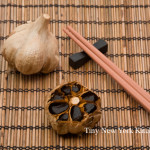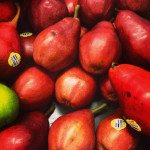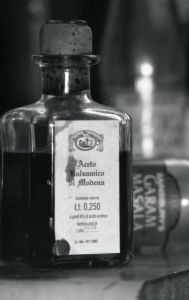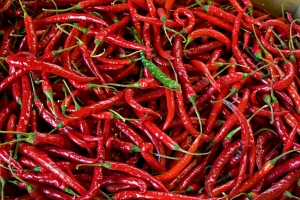Black Garlic
Black Garlic has been around for quite awhile and is an ingredient that chefs have been using across the country. Think of it as “sweet meets savory.” Black garlic is made when heads of garlic are aged under very specialized conditions until the cloves turn black and have a sticky date-like texture. The taste is delicious and unique with a sweet and earthy umami flavor that intensifies nearly any dish you’re creating.
Garlic bulbs are kept for weeks at low temperatures in a humid environment. The enzymes that give fresh garlic its sharpness break down. These conditions also facilitate the Maillard reaction, the chemical process that produces wild new flavor compounds responsible for the deep taste of seared meat and fried onions.
Black garlic’s flavor is described as tasting like aged balsamic, prunes, licorice, molasses, caramel, and tamarind. Use the cloves as you would roasted garlic. Purée with olive oil for a dense and sweet flavor all its own that compliments steaks, chicken, fish and seafood. Smear the paste on crostini or incorporate it into dressings. Use in a braise to intensify the umami-rich flavor of spare ribs. Add to soups, risotto, noodle and rice dishes, and cheese dips. Black garlic also pairs well with blue cheese.
Black garlic also comes in a dehydrated powder that is considered an umami pixie dust. Just sprinkle a bit of it on anything that begs for depth and earthiness.
Most likely you won’t find black garlic at your local neighborhood market, but some Whole Foods will carry it. I’m lucky enough to get mine at Kalustyan’s in New York City. You can certainly get it online at Amazon or other specialty online food sources.
“Work With What You Got!”
© Victoria Hart Glavin Tiny New York Kitchen © 2016 All Rights Reserved
Cooking With Lemons
Lemons are a chef’s secret ingredient. Most chefs will tell you that acidity elevates any dish. There is no need to get all fancy by using twenty year old balsamic vinegar. Just finish most of your dishes with a humble squeeze of lemon juice. Most line cooks have quart containers of wedges at their stations for juicing in the moment. Why lemon? Aside from the fact that you can always find one, you’ll taste what it does to the food, not the lemon itself. Along with salt and pepper, it’s all you need to season everything from simple pastas to grilled fish, roasted meats, and sautéed vegetables, as well as pan sauces, grain salads, and even run of the mill lentil soup. In your own kitchen cut lemon wedges ahead of time, then squeeze as you cook for the brightest flavor.
“Work With What You Got!”
© Victoria Hart Glavin Tiny New York Kitchen © 2016 All Rights Reserved
You must think like a child with the eyes of a chef, open and naive. Never say something doesn’t work or is impossible to do. – Juan Mari Arzak
Good cooking is an art which is easily acquired. There are only a few basic processes, and once they are mastered, even elaborate dishes seem simple. No cookbook can provide the spark of genius, but it can serve as a source of inspiration and information. -Fanny Farmer
In Italy, true balsamic vinegar is not considered an acidic ingredient for salad dressings, but rather a condiment to sprinkle on grilled meats or the best strawberries of the season. There are three very different kinds available: aceto balsamico tradizionale, commercial, and condiment.
Aceto balsamico tradizionale, or “traditional balsamic vinegar,” is made in small quantities under rigorously controlled conditions in and around the towns of Modena and Reggio Emilia in Emilia-Romagna. This artisanal product is protected by Italian law and by the European Union’s designation of original standards. Created from the boiled-down juice of sweet white grapes (traditionally Trebbiano), it has an underlying sweetness and takes on additional complex flavors from sequential aging in chestnut, oak, and other wood barrels. The long aging further evaporates the liquid, giving it a slightly viscous body. The name comes from balsanum, Latin for an aromatic resin that soothes and relaxes (the English balm is from the same word), indicating that the condiment was originally considered healthful and even used as medicine. Tradizionale must age for 12 year, so it is always expensive, but worth every penny.
Mass-market commercial balsamic vinegar, which is made from artificially flavored red wine and is not aged, is sometimes labeled “balsamic vinegar of Modena.” To improve its flavor and body, add a large pinch of brown sugar for every cup of vinegar.
Condimento balsamic vinegar is often good, and can be a fine alternative to commercial balsamic of questionable quality and the excellent but expensive tradizionale. It is usually made in Modena or Reggio Emilia, and often follows many of the same traditional manufacturing methods as its pricey relative. But unlike aceto balsamico tradizionale, condiment is not protected by a determined set of standards, so big differences can exist among brands. When you find one you like, stick with it.
Many chefs use a drizzle of boiled-down balsamic vinegar to decorate plates and act as an additional flavoring element. To make this useful garnish, boil 1 cup commercial balsamic vinegar in a nonreactive saucepan over a high heat until it has reduced by about three-fourths and is thickened and syrupy. It will keep indefinitely stored in a tightly closed jar at room temperature.
To keep your Mexican dishes authentically delicious, here are some pointers about chiles. If you were asked to identify one characteristic that would singularly describe Mexican dishes, the “chile” would be the answer, namely chile peppers. Whether ground, whole, sliced, diced, pickled, fresh, canned or dried, chile peppers are an inherent part of Mexican dishes.
There are many varieties of chiles, ranging from mild to very hot! Chefs use whatever chiles are available to them. Some varieties are available canned when they aren’t available fresh. Here is a list of some common peppers.
Green Peppers: Also called bell peppers. They are very mild peppers and are used in salads as a garnish and they are used to flavor & color dishes.
Anaheim: Also called California peppers. They are mild, long green chiles. They can be eaten raw and are used in salads.
Jalapenos: They are smaller sized and dark green chiles. They are typically very hot.
Serranos: They are smaller and slimmer than jalapenos, but be warned they are hotter too!
Ancho: These chiles are plump and dark green chiles that range from mild to medium. Ancho means “wide,” that’s why these are usually the best choice for chile rellanos.
Yellow Hots: They are longer than jalapenos and moderately hot. These chiles are used in hot mixes, along with other chiles and are used in salsas. They are also used as a garnish to color dishes.
Wax Chiles: These chiles are small, slender, yellow chiles and are used in pickled mixes, in salsas and as a garnish.
Chilitepins: These chiles are tiny and seedy red peppers. They are used for seasoning in salsas in combination with other chiles. They are also used in pickling. Warning…they are VERY hot!
You can roast chiles over the top burner of your stove. Make sure to turn frequently to keep the chiles from burning. You can cook three to four chiles at a time. When the skins turn dark brown and look blistered then remove them from the heat. Wrap the chiles in a damp kitchen towel or paper towel to make the skins easier to remove.
Chiles can be roasted in an oven as well. Place the chiles onto a parchment paper lined baking sheet. Bake at 350º F. until the skins are brown and blistered. After roasting, wrap the chiles in a damp kitchen towel for a few minutes. Then remove the skins.
You can also dry chiles. To dry chiles, make a chile “garland.” Sting chiles up by their stems to make a cluster. Let them hang to dry by placing them in a very dry place until they become dry. Fresh green chiles turn from green to red when left to dry out. Dried chiles are ready to use when they are crackly-dry.
Chile garlands can also be used for decorations in your kitchen, living room or patio. These sartas or ristras are a characteristic sight in the Southwest.
To use dried chiles, just soak them in a hot water bath until they are softened. Open the chiles up and remove the stem and seeds. Puree them in a food processor or blender. Add small amounts of water to process. If the chiles are hot then add a water and vinegar mixture to help tame the chiles. When a chili paste is made then make sure to pass through a sieve to make a smooth paste. Season the paste as you desire to make salsas or for cooking.













